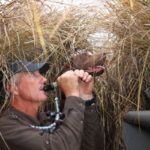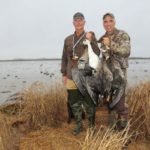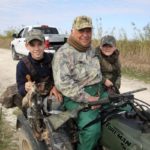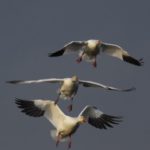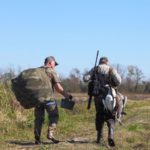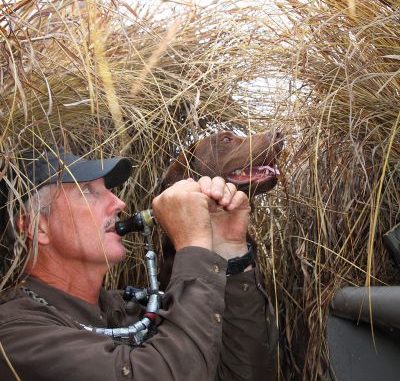
Whether you head to Laccasine NWR or one of the nearby clubs, you’ll find plenty of waterfowling action.
Lacassine or Lacassane?
With so many ducks and geese flying around the agricultural region in the Southwest Louisiana, it’s easy to get confused. There are public hunting opportunities in Lacassane … no, wait, I mean Lacassine. Dang it!
Actually, both are correct. Let me explain.
During the 2013 Southeastern Outdoor Press Association’s annual conference in Lake Charles, I had the opportunity to sign up for one of the media excursions that showcased the tremendous waterfowl hunting around the region.
I was connected with Sammy Faulk, owner and operator of Gotta Go Charters. And through Faulk, connected with Jude Zaunbrecher, the farm manager for the Lacassane Company and head guide for the Lacassane Club.
Fellow outdoor writer Glynn Harris also signed up for the waterfowl hunt and he and I would hunt the Lacassane Club with Zaunbrecher the third weekend in November.
Earlier in the fall, I also put in for one of the Lacassine National Wildlife Refuge senior lottery hunts. It’s a lottery hunt that costs you nothing but a 3×5 index card, an envelope, the price of a postage stamp, and the time to fill it out. Being past the minimum 55 years of age to participate, I qualified for the lottery hunt.
Lacassine NWR also holds youth lottery hunts, where adults can participate in the hunt with the youngster they’re chaperoning. It’s a great opportunity for a family and a lasting memory to share.
Apparently I’d been living right. As luck would have it, I drew out for the refuge hunt, where in a 30-day span I would be hunting both public and private land on properties that border each other.
When I told people I’d be hunting in Lacassine and Lacassane they’d get a perplexed look on their face.
“The same place twice?” they’d ask seemingly puzzled by my good fortune.
“No,” I’d reply. “I’m hunting Lacassine and Lacassane.”
“So what’s the difference if they’re in the same place only spelled differently?” I’d get back from them in sort of a bemused acknowledgement.
“Never mind!” I’d ultimately say in frustration.
Lacassane’s private Eden
When I met Zaunbrecher he reminded me of a character right out of an old western movie or Louis L’ Amore novel. Standing 6 feet, 3 inches tall and weighing 210 pounds, the 55-year-old guide has those slight weathered features that go with a man who works outside.
But, he is also someone who displays the confident-but-affable demeanor necessary to ensure guest hunters not only get the opportunity to harvest a few ducks and geese, but also have a good time while doing it.
One of the keys for the club’s success during the season is paying attention to the amount of pressure they put on the waterfowl. Zaunbrecher, whose family came to the region to farm in 1953 before he was born, said that even though they hunt almost daily, the pressure on the ducks and geese is minimalized as much as possible.
“We hunt nearly 95 percent of the days that the season is open,” he said. “Some days if we don’t have clients we might let the birds rest, but we pretty much hunt every day. The Lacassane Club actually has 27 blinds we can rotate between. We set it up like that so we wouldn’t over pressure the birds.
“But, 90 percent of (the success) is location. We have Lacassine National Wildlife Refuge just to the south of us, and we’re right between Sweet Lake and that alleyway where waterfowl like to stay.”
Just because the Lacassane club is perfectly situated in one of the sweet spots of the migration corridor doesn’t mean limits of birds are guaranteed. Zaunbrecher said there are things you have to do to be successful.
When it comes to blinds, the head guide said he and the other guides think about what they are doing and how to ensure their clients have the highest likelihood of harvesting waterfowl — particularly white-fronted geese.
“What you want to do and one of the main things we try to do, is keep our blinds as natural as possible,” Zaunbrecher explained. “We don’t plow our levees that we put our blinds on. We’re just trying to make it look like the rest of the levee. We want to blend in. That’s the main ingredient. We try to make it look as natural as the rest of the levee looks, so you’re not a sore thumb sticking out.”
It became obvious Zaunbrecher knew what he was talking about when the first pass of geese looked over the decoys and immediately committed to setting down amongst them. And the way our guide positioned the eight speckle belly imposters into the wind they had to pass directly over the blind with their butts down and feet extended.
When Zaunbrecher hollered, “Shoot-em,” Harris and I unloaded at the big birds. In the first pass we had one-third of our speck limits on the ground.
“People complain about our blinds having too much grass,” Zaunbrecher said, with more than a hint of satisfaction. “But I would rather not be seen by anything. It’s human nature to want to look at what’s going on and that’s the first thing ducks and geese see are faces — especially when the sun is shining.
“I’d rather have people complaining about all the grass that got hung up on their gun and how they couldn’t get off a shot. At least you’re getting some shots. It’s pretty much our philosophy out here — keep it as natural as you can and keep the blind covered.”
Decoy deployment is something else Zaunbrecher and the Lacassane Club guides pay close attention to. Year in and year out, when it comes to decoying geese, particularly in the agricultural fields they hunt, they’ve learned it’s a numbers game.
“For geese, early in the season you don’t really need a lot,” Zaunbrecher said. “Some people prefer to not use many at all, and they’ll use only two or three. But later in the year, geese start to body up. So we’ll start to use more and more. During the two-week speck season when the duck season is closed, we’ll sometimes put out six or seven dozen decoys. We’re just trying to make it as realistic as possible.”
Going public at Lacassine
South of Lacassane Company property, Lacassine National Wildlife refuge has a similar philosophy when it comes to limiting hunter pressure on waterfowl for the youth and senior lottery hunts.
Hunts are held only on Wednesdays and Saturdays on the refuge, during the second split of the coastal waterfowl season.
Lucky lottery hunters that drew out in 2014 are assigned an area. Beyond that, they have to provide their own decoys, do their own calling and figure out where to set up a blind. In past years, like on our hunt in 2013, blinds were assigned.
Hunters were encouraged to arrive prior to the day of their hunt to learn the ropes and get their bearings. During my senior hunt on Lacassine, my hunting partners and I arrived the afternoon before, checked out the blind we were assigned and set out the decoys. We were set the next morning.
There’s always something special about those moments prior to legal shooting light, and it was certainly no different at Lacassine NWR. We could hear whistling wings in the starlit morning, leaving us giddy over our prospects.
The number of ducks that flew into our flooded field on the first pass did not disappoint us. They made a classic circle around our decoys and came straight on in. We picked up three ducks, a mallard drake, a hen and a spoonbill.
After we harvested two more birds, then another, and missed a couple others, it seemed that filling a limit was a foregone conclusion.
But, the shooting slowed up, and we soon spotted an obvious problem. Lacassine NWR has almost too much of a good thing — acres upon acres of prime waterfowl habitat and little pressure between blinds. The ducks had too many options.
“The area your lottery hunt was held in is just over 880 acres with nine blinds, but we only hunt five per year and it’s in an area that is planted in millet,” said Lacassine NWR manager Richard Myers. “In fact, it’s all millet. It’s specifically engineered for waterfowl and is a variety of Japanese millet called chiwapa.
“It makes a big head and the later in the winter it gets, it’s a good food source for ducks. It’s easy to plant and is low maintenance. There’s not much they have to do to it.”
For us, so much chiwapa millet turned out to be too good of a food source. Pressure-sensitive ducks flew to other areas to settle in for the day to rest and feed. Nonetheless, it was amazing to see how many birds the refuge holds for lucky lottery hunters who draw out for youth and senior hunts, when there is plenty of feed and little hunting pressure.
“We hunt only the second split to allow the birds to sit longer undisturbed,” Myers said. “In the past we hunted the first split, and by hunting the second split that improves the quality of the hunts. They’re getting shot at everywhere else around here. So they get comfortable here.”
Whether you hunt Lacassane or Lacassine the one thing you’ll learn is there is no lack in either when it comes to waterfowl numbers. And, what’s important is it’s an area where you can take advantage of both public and private hunting opportunity.
